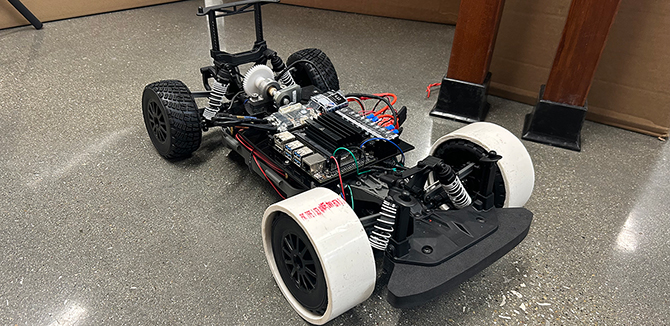Drifting into a New Space
Meg Sindelar (MSR ‘23) talks about creating a drifting autonomous parallel parking remote-control car.

There’s parallel parking like teenagers learn before their driver’s test, and then there’s parallel parking like Meg Sindelar (MSR ‘23) envisions it.
Sindelar is a student in Northwestern Engineering's Master of Science in Robotics (MSR) program. For her winter quarter independent project, she built a remote control (RC) car that can parallel park itself by reversing at high speeds before spinning 180 degrees precisely into the spot.
If that sounds difficult to engineer, that’s because it was.
“I had never worked with RC cars or any type of RC system before this,” Sindelar said. “My project changed completely throughout the quarter.”
The original goal was to train a vehicle to parallel park autonomously, mostly because Sindelar doesn't like to parallel park. But after a friend showed her a video of an RC car powersliding into a parking space like it was straight out of a movie, Sindelar decided to shoot for something a little more flashy.
Sindelar found hardware component recommendations to build the car online and jumped into the project. That, however, proved to be a time-consuming lesson learned.
What was supposed to be the most efficient route to a successful project turned into endless hours of debugging and retooling as she tried to make the components from other people’s plans fit together while meeting the specific needs of the system she was designing.
“I originally figured that would be the best and quickest way for me to get the car up and running,” she said. The needs of this specific project, however, differed from the existing plans, which caused problems. “I realized in the end it was better to just start from scratch when creating a circuit design and buying components because then you understand why you bought each specific component and how it will best work with your specific system.”
With the hardware taking longer than expected, Sindelar’s RC car project reached a crossroads: should she continue working on the hardware or switch to simulation to enable her to focus more on algorithms? Ultimately she decided to continue building the car and use any means necessary to make it drift into a parallel parking spot.
“I think it’s a much more interesting problem to have a car in real life drift into a parking spot,” she said. "I had been working through this real system for so long and had already learned so much and knew I was close to solving it. I stubbornly couldn’t give up.”
Sindelar said the technical challenges she faced turned out to be a benefit to her education.
“I am so glad I decided to stick with the physical system,” she said. “I have built so many necessary and unexpected hardware design and debugging skills, and still had time to implement a successful algorithm.”
That experience will have benefits for her far beyond the end of the course.
“I am most proud of my determination,” she said. “This experience will definitely prepare me for the rest of MSR because of the will I found while creating this project, as well as the knowledge I have gained, both with hardware and software.”

